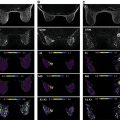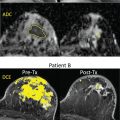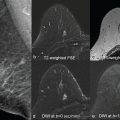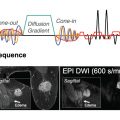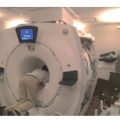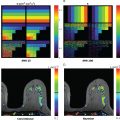Data Acquisition
Essential Elements of Calibration (B 0 And B 1 )
Most breast diffusion scans are performed with fat suppression and an echo-planar imaging (EPI) readout. Both these elements have optimal performance with uniform B 0 (magnet) and B 1 (radiofrequency) fields. Homogeneity of these fields heavily depends on the patient body habitus and positioning of the breasts with respect to the magnet and the radio frequency (RF) transmit coil, especially at 3 T. At this field strength, patient specific RF shimming realizes signal uniformity over both breasts as well as uniform fat suppression. Before the actual scan, a B 1 map is generated to optimize the RF transmission settings to realize a uniform transmit field. A similar strategy is used for image-based B 0 shimming for which a B 0 map is acquired before the diffusion-weighted imaging (DWI) scan. The acquisition of the B 0 map is integrated in the SmartSurvey scan that is the basis for automated, operator-independent planning of the scan geometry. In the B 0 map, segmentation is performed such that shimming is optimized over the breasts and axillae, the clinically relevant areas. This image-based B 0 shimming allows for optimal and reproducible fat suppression in bilateral breast magnetic resonance MRI. In case there is focus on a single breast, a shim volume can be planned to optimize the shimming over the indicated location. The three features of patient body habitus, adaptive B 0 and B 1 shimming, and automated planning of scan geometries are bundled in the SmartExam Breast option, which allows for robust and reproducible B 0 shimming for optimal fat suppression and minimal EPI distortion, optimal B 1 shimming for signal uniformity, and reproducible planning.
Another important aspect for system calibration is the compensation for eddy currents, which arise due to switching gradients and lead to signal loss and distortion. Especially with strong diffusion encoding gradients, these effects can be significant. Eddy current effects are minimized by intrinsic design of the hardware and by preemphasis to compensate upfront for the expected deviations in gradient trajectories. Proper eddy current compensation allows us to use the Stejskal–Tanner type of diffusion encoding without the need for additional sequence compensations, such as twice-refocused diffusion encoding.
Essential elements of acquisition and reconstruction
A DWI sequence consists of the following modules: diffusion encoding, fat suppression, readout, and reconstruction. It is possible to perform diffusion imaging without fat suppression, but the use of fat suppression is general practice and recommended in the guidelines. Readout and reconstruction can be regarded as two separate modules, but as these are very much interdependent, we cover them together.
Diffusion Encoding
For the diffusion encoding, the monopolar Stejskal–Tanner encoding scheme is most commonly applied, which is also the default in Philips systems. The diffusion gradient strengths and timings are automatically optimized, considering the parameters in the protocol as set by the echo time (TE), field of view (FOV), and acquisition voxel sizes. With the “specialist option,” the user can opt to set diffusion times and gradient timings manually, and to use a twice-refocused or a more time-efficient asymmetrical non-Stejskal–Tanner encoding scheme. In the latter, dead times in the diffusion encoding module are avoided. This results in a shorter TE but introduces an off-center bias due to concomitant fields.
For DWI, the diffusion encoding gradients are applied in three orthogonal directions, either along the imaging plane axes or via a vector optimized combination of the physical gradient axes independent of the slice orientation, to minimize TE (gradient overplus). An arbitrary number of b values can be chosen with a maximum b value of 25,000 s/mm 2 . As the signal-to-noise ratio (SNR) decreases with increasing b value, the number of signal averages (NSA) can be set per b value to allow multiple averages to recover SNR for the higher b values while maintaining a low number of averages for the lower b values to gain efficiency.
For diffusion tensor imaging (DTI), predefined schemes are available, as well as the possibility to define any user-defined scheme of b values and orientations of the diffusion encoding gradients.
Fat Suppression
Several fat-suppression techniques are available based on spectral and/or T1 relaxation differences between water and fat protons. Different types of inversion pulses like short tau inversion recovery (STIR), spectral presaturation with inversion recovery (SPIR), and spectral attenuated inversion recovery (SPAIR) exist, as well as slice selective gradient reversal (SSGR) fat suppression, in which the slice encoding and refocusing gradient in a spin-echo acquisition have opposite polarity to avoid refocusing of excited fat protons. STIR exploits slice selective presaturation based on T1 relaxation. The combination of STIR with diffusion encoding, multiple averages, and inversion processing is referred to as DWIBS ( Fig. 17.1 ; see Chapter 11 ). SPIR and SPAIR are spectrally selective presaturation pulses. Looking at these techniques individually, STIR has the best fat suppression performance, but a penalty in SNR is paid, as the water signal will also be partially saturated. From the spectrally selective inversion pulses, SPIR allows time-efficient shorter inversion times and has far less RF power deposition in the body (lower specific absorption rate [SAR]), as the inversion pulse is not of adiabatic nature, and a lower flip angle is used compared with SPAIR pulses. This comes at the cost of sensitivity to B 1 nonuniformity. The best fat-suppression performance is realized when the different technologies are combined. The system allows to combine STIR, SPIR or SPAIR, and SSGR. From sequence optimization perspective, SSGR can easily be added to the inversion techniques, as it does not affect optimal sequence timings. On the other hand, combining STIR and SPIR/SPAIR needs careful planning of the inversion and repetition times with respect to steady state such that optimal fat saturation is realized.
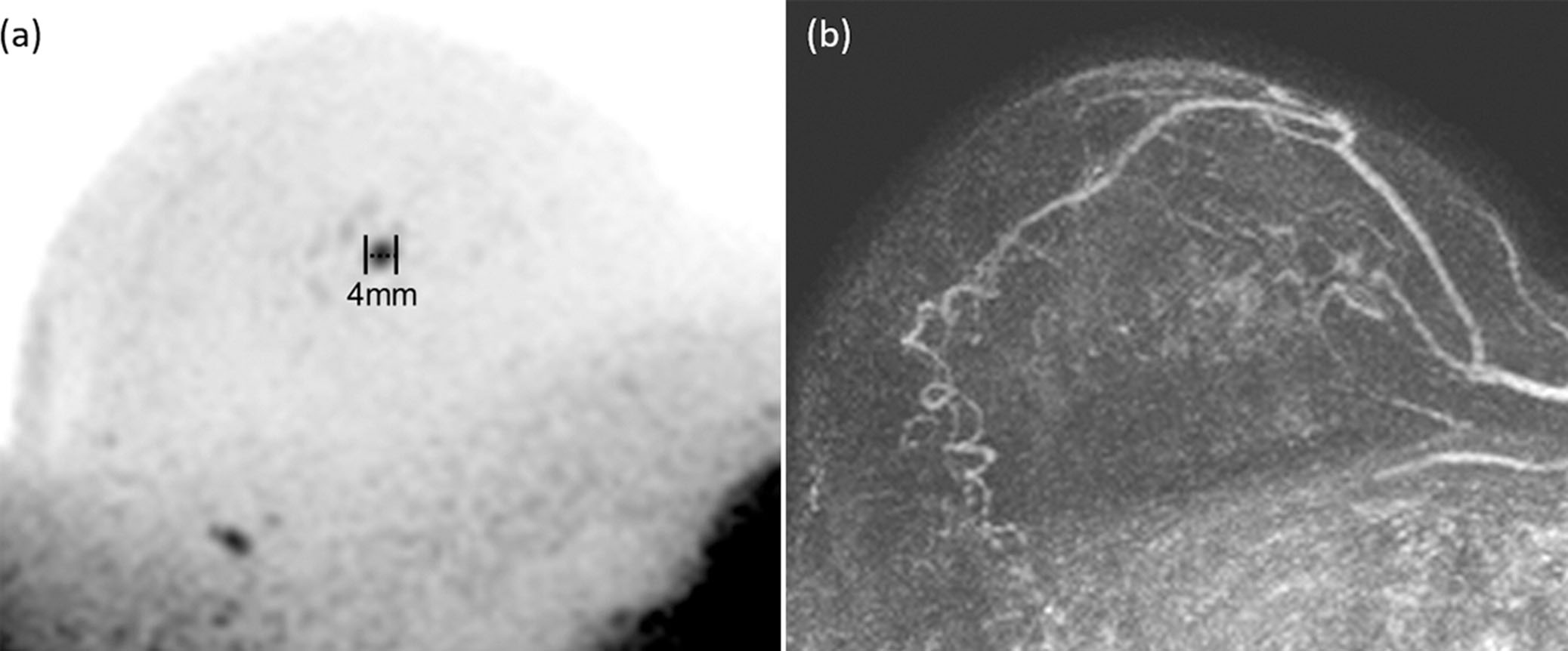
Readout and Reconstruction
Single-shot spin-echo EPI is the workhorse for DWI, as it is a very time-efficient readout strategy for the generally long acquisition nature of diffusion scans. The EPI readout train can be reduced with the acceleration techniques SENSE (Sensitivity Encoding) or Compressed SENSE. A shorter readout train is beneficial, as it reduces (1) the TE and thus minimizes T2 shine-through and signal loss due to T2 decay and (2) the distortion related to B 0 inhomogeneity. Of all parallel imaging techniques, SENSE is the most SNR efficient, allowing the use of maximal reduction factor with respect to the geometrical capabilities of the coil. Compressed SENSE adds additional reduction capabilities by using sparsity of the image data to remove g-factor-related noise. Minimizing the EPI train length with these acceleration techniques therefore improves image quality but does not lead to a shorter scan time, as it does not affect the minimally required repetition time (TR). MultiBand SENSE ( Fig. 17.2 ), in which multiple slices are excited simultaneously, is designed to reduce scan time. This reduction is especially useful for long scans with multiple averages, b values, and/or directions, such as DTI acquisitions and scans used for intravoxel incoherent motion (IVIM) or kurtosis processing. Applicable acceleration factors of SENSE, Compressed SENSE, and MultiBand SENSE increase with the number of receiver elements of the coil being used. Depending on the type of scanner, 2-, 4-, 7-, or 16-channel breast coils are available.
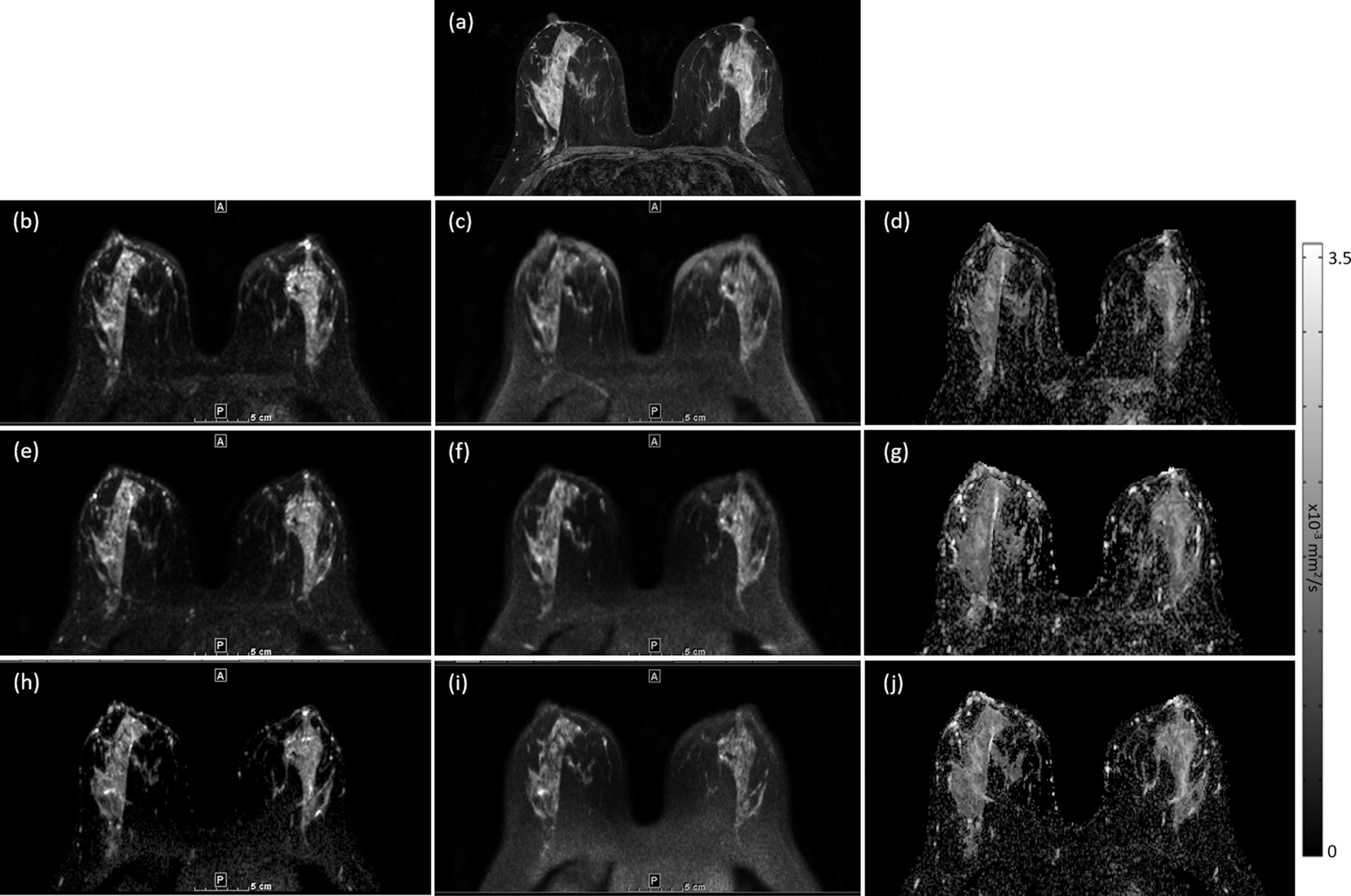

Stay updated, free articles. Join our Telegram channel

Full access? Get Clinical Tree



